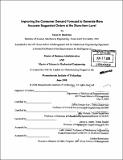Improving the consumer demand forecast to generate more accurate suggested orders at the store-item level
Author(s)
Bankston, Susan D
DownloadFull printable version (20.38Mb)
Other Contributors
Leaders for Manufacturing Program.
Advisor
David Simchi-Levi Roy Welsch and David E. Hardt.
Terms of use
Metadata
Show full item recordAbstract
One of the biggest opportunities for this consumer goods company today is reducing retail stockouts at its Direct Store Delivery (DSD) customers via pre-selling, which represents approximately 70% of the company's total sales volume. But reducing retail stock-outs is becoming constantly more challenging with an ever-burgeoning number of SKUs due to new product introductions and packaging innovations. The main tool this consumer goods company uses to combat retail stock-outs is the pre-sell handheld, which the company provides to all field sales reps. The handheld runs proprietary software developed by this consumer goods company that creates suggested orders based on a number of factors including: * Baseline forecast (specific to store-item combination) * Seasonality effects (i.e., higher demand for products during particular seasons) * Promotional effects (i.e., lift created from sale prices) * Presence of in-store displays (i.e., more space for product than just shelf space) * Weekday effects (i.e., selling more on weekends when most people shop) * Holiday effects (i.e., higher demand for products at holidays) * Inventory levels on the shelves and in the back room * In-transit orders (i.e., orders that may already be on their way to the customer) The more accurate that the suggested orders are, the fewer retail stock-outs will occur. This project seeks to increase the accuracy of the consumer demand forecast, and ultimately the suggested orders, by improving the baseline forecast and accounting for the effect of cannibalization on demand.
Description
Thesis (M.B.A.)--Massachusetts Institute of Technology, Sloan School of Management; and, (S.M.)--Massachusetts Institute of Technology, Dept. of Mechanical Engineering; in conjunction with the Leaders for Manufacturing Program at MIT, 2008. Includes bibliographical references (p. 57).
Date issued
2008Department
Leaders for Manufacturing Program at MIT; Massachusetts Institute of Technology. Department of Mechanical Engineering; Sloan School of ManagementPublisher
Massachusetts Institute of Technology
Keywords
Sloan School of Management., Mechanical Engineering., Leaders for Manufacturing Program.